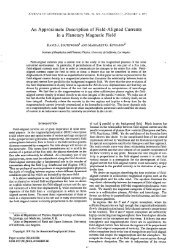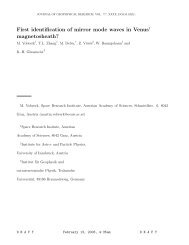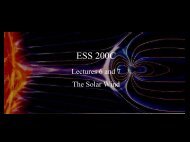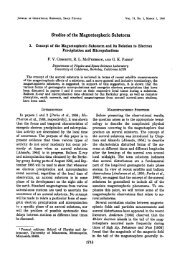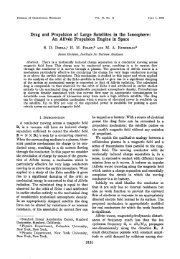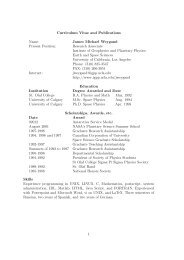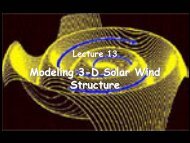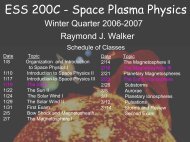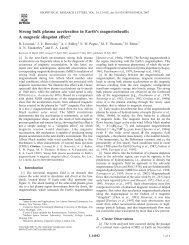Outer magnetospheric structure: Jupiter and Saturn compared
Outer magnetospheric structure: Jupiter and Saturn compared
Outer magnetospheric structure: Jupiter and Saturn compared
You also want an ePaper? Increase the reach of your titles
YUMPU automatically turns print PDFs into web optimized ePapers that Google loves.
A04224<br />
WENT ET AL.: OUTER MAGNETOSPHERIC STRUCTURE<br />
A04224<br />
at a given r <strong>and</strong> w, can be successfully constrained by a less<br />
stretched configuration.<br />
[14] The effect described above is negligible in the low‐b<br />
inner magnetosphere (dominated by <strong>Jupiter</strong>’s strong internal<br />
dipole) however it becomes increasingly important at larger<br />
radial distances where the plasma <strong>and</strong> magnetic pressures<br />
become comparable. Since the cushion region itself is found<br />
at large (>50 R J ) radial distances, the quasi‐dipolar nature of<br />
the cushion region field suggests, in light of equation (1), that<br />
the Jovian outer magnetosphere is depleted of <strong>magnetospheric</strong><br />
plasma relative to the radially stretched magnetodisk.<br />
In this picture the cushion region consists of flux tubes which<br />
have recently lost much of their mass content as a result of<br />
Vasyliũnas <strong>and</strong> Dungey cycle reconnection while the transition<br />
region corresponds to the distorted outer edge of the<br />
magnetodisk. Dense clumps of plasma occasionally break off<br />
the outer edge of the magnetodisk <strong>and</strong> move through the<br />
overlaying cushion region where they are observed in magnetic<br />
field data as sharp decreases in the total magnitude of the<br />
magnetic field. These are the “magnetic nulls” of Haynes<br />
et al. [1994].<br />
2.2. Spatial <strong>and</strong> Temporal Variability<br />
[15] A total of six magnetometer‐carrying spacecraft have<br />
explored the Jovian magnetosphere to date (Pioneer 10,<br />
Pioneer 11, Voyager 1, Voyager 2, Ulysses <strong>and</strong> Galileo; see<br />
Figure 3) covering all local times in the equatorial plane out<br />
to distances of ∼100 R J . New Horizons was not equipped with<br />
a magnetometer <strong>and</strong>, while Cassini skimmed the dusk magnetosphere<br />
en route to <strong>Saturn</strong>, it did not penetrate far enough<br />
for the full <strong>magnetospheric</strong> <strong>structure</strong> to be determined. Considered<br />
together, the available observations reveal significant<br />
temporal <strong>and</strong> spatial variability in the properties of the<br />
cushion region described above.<br />
[16] Considering the temporal variability first, the expansion<br />
<strong>and</strong> contraction of the Jovian magnetosphere (usually<br />
an equilibrating response to changes in solar wind dynamic<br />
pressure) is thought to result in magnetopause <strong>and</strong>, by<br />
extension, cushion region motion, relative to the planet, at<br />
velocities comparable to or greater than those of an exploring<br />
spacecraft [Sonnerup et al., 1981; Cowley <strong>and</strong> Bunce, 2003].<br />
In the rest frame of the planet this motion results in the<br />
cushion region “sweeping” back <strong>and</strong> forth over the exploring<br />
spacecraft at the same time as the spacecraft itself moves<br />
relative to <strong>Jupiter</strong>. The inbound leg of the Pioneer 10 flyby<br />
illustrates this point well with the spacecraft crossing the<br />
cushion region‐to‐magnetodisk boundary 3 times in the<br />
space of just 3 days, covering a radial distance of over<br />
40 R J while doing so. Such dynamical considerations act<br />
to modulate the time a spacecraft spends inside the cushion<br />
region <strong>and</strong> makes the true “inertial” thickness of the region<br />
impossible to determine from single spacecraft data. The<br />
same unpredictable boundary motion also has consequences<br />
for the stability <strong>and</strong> thickness of the underlying plasma sheet<br />
<strong>and</strong> is likely to control the probability of plasma blobs<br />
breaking off from the magnetodisk [Southwood <strong>and</strong> Kivelson,<br />
2001]. This may, in turn, introduce a temporal variability<br />
to the nature <strong>and</strong> extent of cushion <strong>and</strong> transition region<br />
field fluctuations. Other potential sources of variability, such<br />
as the bursty nature of magnetotail reconnection [Woch et al.,<br />
2002] <strong>and</strong> the variable activity levels seen at Io [Bagenal<br />
et al., 2004] are probably of secondary importance.<br />
[17] From a spatial perspective, Kivelson <strong>and</strong> Southwood<br />
[2005] identified a local time asymmetry in the cushion<br />
region with the region of quasi‐dipolar field being more<br />
evident in the morningside magnetosphere as opposed to<br />
afternoon. In the predusk sector Kivelson <strong>and</strong> Southwood<br />
[2005] found the B R <strong>and</strong> B components to be more comparable<br />
than in the cushion region <strong>and</strong>, while the B R component<br />
reversed sign rather irregularly, clear spectral peaks were<br />
found at the rotation period of <strong>Jupiter</strong>. These observations<br />
were interpreted as a result of the plasma sheet thickening as<br />
it rotates toward dusk, reducing the contrast between centrifugally<br />
stressed <strong>and</strong> plasma‐depleted flux tubes, combined<br />
with a gradual refilling of the cushion region by plasma that<br />
has broken off the outer edge of the dynamically unstable<br />
plasma sheet. Such complex variability is difficult to quantify<br />
in the absence of multispacecraft observations <strong>and</strong>, as a<br />
result, it is beyond the remit of this paper to consider such<br />
variability in detail.<br />
2.3. Average Properties<br />
[18] Previous studies of the cushion region [Smith et al.,<br />
1976; Balogh et al., 1992; Kivelson et al., 1997] considered<br />
spacecraft data on an individual basis only <strong>and</strong>, as we have<br />
seen above, such a study tells us little about the average<br />
properties of the region. We address this problem for the<br />
first time by considering observations made by all <strong>Jupiter</strong><br />
exploring spacecraft to carry a magnetometer to date. We do<br />
this by defining the average thickness of the cushion region<br />
at <strong>Jupiter</strong> to be the average separation between the cushion<br />
region’s inner boundary (projected to the subsolar point using<br />
the Joy et al. [2002] magnetopause model) <strong>and</strong> the mean<br />
subsolar location of the Joy et al. [2002] magnetopause. Here<br />
we use the Joy et al. [2002] magnetopause location determined<br />
from a single‐gaussian fit to the spacecraft observations.<br />
Determining the instantaneous location of the cushion<br />
region’s inner boundary does not require knowledge of the<br />
speed at which the boundary itself is moving though considerable<br />
ambiguity is often involved in its determination due<br />
to the gradual nature of the transition between the cushion<br />
region <strong>and</strong> magnetodisk. To reduce this ambiguity, passes on<br />
which a stable magnetodisk configuration (∣B R ∣ > ∣B ∣, INT ><br />
50°) could not be identified were excluded from the analysis<br />
due to the resulting ambiguity in distinguishing adjacent<br />
<strong>magnetospheric</strong> regions. A total of 13 transition points could<br />
be identified in this way (between 1973 <strong>and</strong> 2003) <strong>and</strong> their<br />
distribution in the equatorial plane is shown in Figure 4.<br />
[19] The mean location of the cushion region’s inner<br />
boundary maps to a subsolar location of 54 R J which suggests<br />
a mean cushion region “inertial subsolar thickness” of order<br />
L CR ∼ 20 R J . The 16 R J st<strong>and</strong>ard deviation in the location of<br />
the inner boundary is similar to that seen in the location of<br />
the Joy et al. [2002] magnetopause <strong>and</strong> is consistent with the<br />
effects of variable solar wind dynamic pressure modulating<br />
the size of the <strong>magnetospheric</strong> cavity. The range of observations<br />
is, of course, larger than the st<strong>and</strong>ard deviation quoted<br />
above <strong>and</strong>, once again, the Pioneer 10 inbound pass provides<br />
a good illustration of the variability.<br />
[20] Uncertainties in both the mean <strong>and</strong> st<strong>and</strong>ard deviation<br />
of the cushion region’s inner boundary were estimated using a<br />
Monte Carlo method similar to that of Achilleos et al. [2008]:<br />
500 r<strong>and</strong>om subsamples, each comprising 75% of the total<br />
number of observations used in this investigation, were used<br />
5of14



